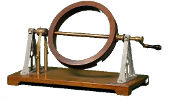» Electromagnetic Tuning Fork with Stylus (0459)
Immagini
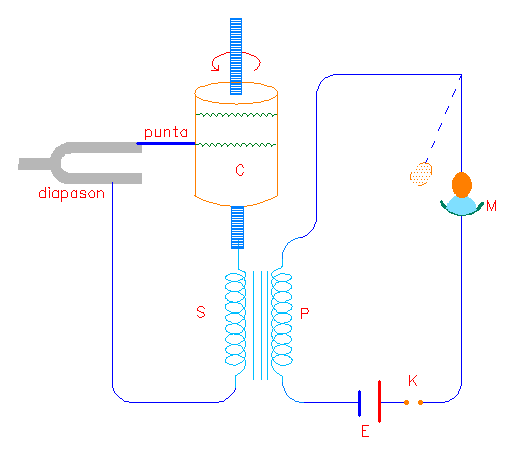
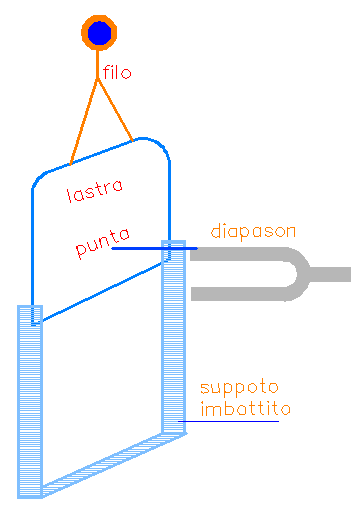
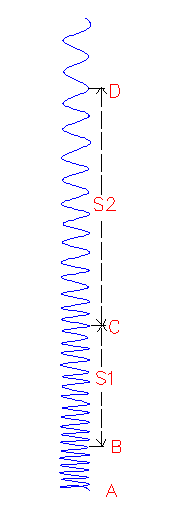
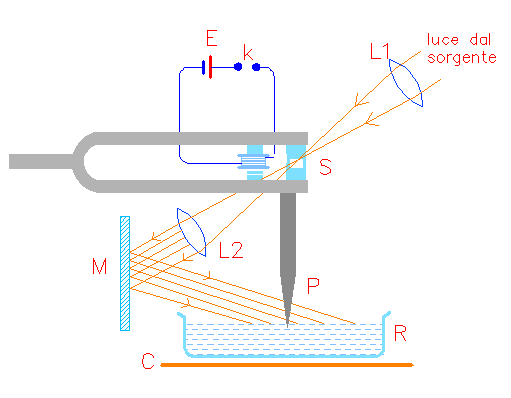

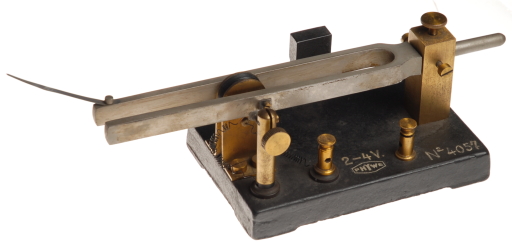
DESCRIPTION
Exhibit 459 is a tuning fork with a stylus on one arm. The vibrations of the tuning fork are maintained by an electromagnet located between the arms. On the metallic base there are two terminals for the direct current connection.
The apparatus can be used for the following experiments:
1. Determination of the frequency of the tuning fork with the Duhamel method- (see ref.1):
In this case the apparatus is used with a recording cylinder on which is wrapped carbon paper placed above a sheet of white paper. The apparatus is mounted so that the stylus rests delicately on the paper. The movement of the cylinder is driven by a worm-screw so that it not only turns but also rises.
If the cylinder rotates, in absence of vibrations of the tuning fork, a helical line will be drawn. If instead the tuning fork vibrates we obtain a sinusoidal curve. The tuning fork is connected to a circuit containing a pendulum (M) with a period of two seconds, a mercury contact and an induction coil. If the pendulum oscillates and touches the mercury, current passes in the prthe metallic base there are two termiimary P and the secondary generates a spark which leaves a black mark on the paper. The number of tuning fork oscillations between the two marks is then the frequency of the tuning fork.
2.
Determination of the tuning fork frequency with the method of the falling glass sheet. (see ref.2):
In this case one uses a smoked glass sheet. The tuning fork is held so that the stylus
barely touches the sheet, that is attached to a support by means of a cotton string.
When the string is burned, the sheet falls with acceleration "g" in a cushioned guide to avoid breakage. If the tuning fork does not vibrate, there will be a vertical line. If it vibrates there will be many oscillations at first that separate more and more as the sheet falls. To determine the frequency, consider point "B"the metallic base there are two termi (see trace in design 3:)
not far from the initial point "A". Choose two other points "C" and "D" such that the number of waves between "B" and "C" correspond to the number of waves between "C" and "D"; the distances (BC) and (CD) are therefore covered in the same time t.
Let BC=S1, CD=S2 and UB the initial velocity at point "B", then
Let ![Formula: [BC = S_1] Formula: [BC = S_1]](/foto/equaz/459_fr01.png)
![Formula: [CD = S_2] Formula: [CD = S_2]](/foto/equaz/459_fr02.png)
![Formula: [U_B] Formula: [U_B]](/foto/equaz/459_fr03.png) initial velocity of the sheet at point "B",then
initial velocity of the sheet at point "B",then
![Equazione: [S_1 =U<sub>B</sub> t +\frac{1}{2}gt^2] Equazione: [S_1 =U<sub>B</sub> t +\frac{1}{2}gt^2]](/foto/equaz/459_eq01.png)
![Equazione: [S_1 + S_2 = 2U<sub>B</sub>t +2gt^2] Equazione: [S_1 + S_2 = 2U<sub>B</sub>t +2gt^2]](/foto/equaz/459_eq02.png)
therefore, one has
![Equazione: [t = \sqrt{\frac{(S_2 - S_1)}{g}}] Equazione: [t = \sqrt{\frac{(S_2 - S_1)}{g}}]](/foto/equaz/459_eq03.png)
If the number of waves between
(B) and (C) or (C) and (D) è (m),
then
the tuning fork frequency
![Formula: [\nu =\frac{m}{t}] Formula: [\nu =\frac{m}{t}]](/foto/equaz/459_fr04.png)
![Formula: [S_1] Formula: [S_1]](/foto/equaz/459_fr05.png) and
and
![Formula: [S_2] Formula: [S_2]](/foto/equaz/459_fr06.png) are measured with a microscope.
are measured with a microscope.
With this method, knowing the frequency of the tuning fork, one can also measure the value of the acceleration due to gravity "g".
3. Determination of the surface tension of a liquid with the Rayleigh method
(see ref. 2 pag. 122)
The liquid to be examined (water in our case) is contained in a transparent glass container placed above a sheet of millimeter paper on which are marked two indicator lines. The stylus is placed so that it barely touches the water surface. When the tuning fork vibrates, the stylus generates small waves which seem to be stationary because of visual persistence. To see them one uses a light ray which passing through a slit "F" is reflected by the mirror "M" and falls on the water surface as illustrated in design 4, making them visible on the underlying millimeter paper. Now it is sufficient to divide the distance between the two indicator lines (design 5) by the number of counted waves to obtain the wavelength. The frequency on the waves is the tuning fork frequency.
Let the wavelength be = λ
The frequency = n
The velocity ![Formula: [{\rm v =n}\lambda] Formula: [{\rm v =n}\lambda]](/foto/equaz/459_fr07.png)
![Equazione: [n\lambda = \sqrt{\frac{\lambda g}{2\pi}+ \frac{2\pi T}{\lambda\rho}}] Equazione: [n\lambda = \sqrt{\frac{\lambda g}{2\pi}+ \frac{2\pi T}{\lambda\rho}}]](/foto/equaz/459_eq04.png)
![Equazione: [T = \frac{\lambda^2 \rho}{4\pi^2}(2n^2\lambda\pi -g)] Equazione: [T = \frac{\lambda^2 \rho}{4\pi^2}(2n^2\lambda\pi -g)]](/foto/equaz/459_eq05.png)
Where T is the surface tension, ρ is the density of water.
The experiment can be repeated with the addition of NaCl from 0.5 up to 5 mole in increments of 0.5 mole (one mole of NaCl = 60 gm) in one liter of water. A graph can show how the surface tension increases with the concentration of salt.
The best frequency for this experiment is about 60 hertz.
ISCRIZIONI
- Il logo PHYWE è inciso in un esagono sulla base di metallo
BIBLIOGRAPHY
- [1] Ganot A., "Traité Élémentaire de physique" Paris, 1868, pag. 497.
- [2] Worsnop B.L., Flint H.T., "Advanced Practical Physics for Students", Asia Publishing House, New Delhi,1961, pag. 429.
Dati Catalografici
| Data di costruzione: | Seconda decade Secolo XX |
|---|---|
| Data di carico: | 1923-06-28 |
| Nr. Inventario: | 4057 (Generale dal 1874) |
| Costruttore: | PHYWE |
| Materiale: | acciaio, ottone, metallo, legno |
| Dimensioni: | Diapason: 24 cm x 2,5 cm x 1 cm; Base di metallo: 15 cm x 9,5 cm x 2 cm; Sostegno metallico del diapason: 2 cm x 2 cm x 6 cm; Lunghezza della punta scrivente: 6,5 cm |
| Conservazione: | ottimo (Funzionante.) |
